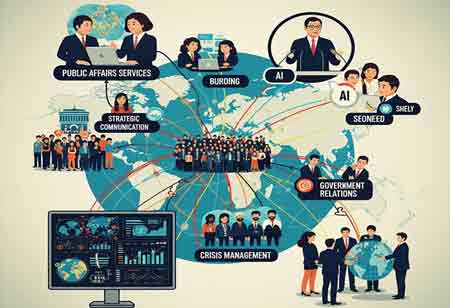THANK YOU FOR SUBSCRIBING
Be first to read the latest tech news, Industry Leader's Insights, and CIO interviews of medium and large enterprises exclusively from Gov CIO Outlook
THANK YOU FOR SUBSCRIBING

By
Government CIO Outlook | Thursday, July 03, 2025
Stay ahead of the industry with exclusive feature stories on the top companies, expert insights and the latest news delivered straight to your inbox. Subscribe today.
The public affairs services industry is shaped by geopolitical currents, rapid technological advancements, and an increasingly interconnected global society. The industry is undergoing a significant transformation, moving beyond traditional lobbying and media relations to new areas of focus. It is now embracing a more proactive, data-driven, and ethically sound approach to stakeholder engagement and reputation management. This shift reflects a heightened awareness of public scrutiny and the need for authentic communication.
At its core, public affairs remains dedicated to influencing public policy, managing perceptions, and building relationships between organizations and their myriad publics, including government bodies, communities, industry associations, and advocacy groups. However, the methods and tools employed in this pursuit have undergone a significant upgrade. The pervasive influence of digital platforms and the proliferation of information have necessitated a more sophisticated understanding of audience segmentation, message resonance, and the real-time dynamics of public opinion.
Strategic Communication and Government Relations in a New Era
One of the most defining characteristics of public affairs is the intensified focus on strategic communication. This involves not only disseminating information but also crafting nuanced narratives that align with an organization's values and objectives, thereby fostering trust and influencing public sentiment. Professionals are increasingly adept at developing messages tailored to diverse audiences, utilizing a multi-channel approach that spans traditional media, social platforms, and bespoke digital campaigns. The ability to articulate complex policy positions in an accessible and compelling manner is paramount.
Government relations, a foundational pillar of public affairs, continues to evolve. While direct engagement with policymakers remains crucial, the scope of this activity has broadened considerably. Public affairs specialists are now deeply immersed in understanding the intricacies of legislative processes at national, state, and local levels, tracking regulatory developments, and providing insightful analysis to their principals. This involves comprehensive research into public opinion, political landscapes, and the socio-economic implications of policy proposals. The goal is to facilitate informed decision-making and ensure that organizational perspectives are effectively represented in policy discourse.
The Digital Revolution: Data, AI, and Media Dynamics
The ascendancy of data analytics and AI is fundamentally reshaping the public affairs profession. These technologies are no longer nascent concepts but integral tools for enhancing efficiency and efficacy. AI-powered platforms are being leveraged for advanced media monitoring, sentiment analysis, and the identification of emerging issues. Predictive analytics enables professionals to anticipate potential risks and opportunities, allowing for a more proactive approach in reputation management and issue advocacy. The integration of AI streamlines routine tasks, freeing public affairs teams to focus on strategic thinking, creative content development, and relationship building. However, the ethical implications of AI usage, particularly concerning data privacy and algorithmic bias, are a significant consideration, driving the need for robust governance frameworks within the industry.
Beyond direct government engagement, public affairs encompasses a broader spectrum of advocacy. This includes coalition building, where organizations collaborate with like-minded entities to amplify their collective voice on shared concerns. Grassroots mobilization has gained renewed prominence, empowering individuals and local communities to participate in public discourse and advocate for specific causes. Public awareness campaigns, often utilizing digital tools and engaging content, are designed to educate the public and garner support for particular policy outcomes or societal initiatives.
The evolving media landscape also significantly impacts public affairs. The decline of some traditional news outlets and the rise of subscription-based models necessitate a more diversified media relations strategy. Public affairs professionals are increasingly engaging with independent journalists, niche online publications, newsletters, and podcasts, recognizing their growing influence in shaping public opinion. The ability to identify and cultivate relationships across this fragmented media ecosystem is crucial for effective message dissemination.
Crisis Management and Future Outlook
In an era of heightened public scrutiny and rapid information flow, crisis management has become an indispensable component of public affairs. Organizations are investing heavily in preparedness, developing comprehensive crisis communication plans, and establishing rapid response protocols. The ability to swiftly and transparently address unforeseen events, manage reputational fallout, and maintain public trust in real-time is a hallmark of effective public affairs practice.
The public affairs services industry is poised for continued growth, driven by the increasing complexity of global governance, the imperative for corporate social responsibility, and the relentless pace of technological innovation. The demand for professionals who possess a blend of strategic communication expertise, policy acumen, data literacy, and a deep understanding of stakeholder dynamics will continue to rise. The industry's trajectory points towards even greater integration of digital tools, a stronger emphasis on authentic engagement, and a perpetually adaptable approach to navigating the multifaceted world of public affairs. The foundational objective remains constant: to bridge the gap between organizations and the public, fostering understanding, influencing policy, and ultimately contributing to a more informed and engaged society.
I agree We use cookies on this website to enhance your user experience. By clicking any link on this page you are giving your consent for us to set cookies. More info



